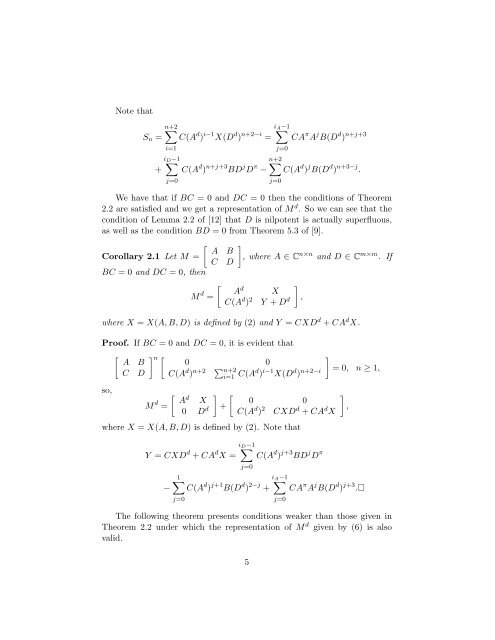A note of the representation of the Drazin inverse of 2x2 block matrix
A note of the representation of the Drazin inverse of 2x2 block matrix A note of the representation of the Drazin inverse of 2x2 block matrix
thenM d =[ ] AdX0 D d +∞∑[ A BC Dn=0] n []0 0C(A d ) n+2 ∑ n+2i=1 C(Ad ) i−1 X(D d ) n+2−i , (6)where X = X(A, B, D) is defined by (2).Proof. We rewrite M = P + Q, where P =By Theorem 1.1,P d =[ ] AdX0 D d ,[ A B0 D]and Q =[ 0 0C 0where X = X(A, B, D) is defined by (2). Now, we have that the conditionP π Q = Q is equivalent to−(AX + BD d )C = 0, (7)D π C = Cwhile the condition P QP π = 0 is equivalent toSince,AX + BD d =i D −1BCA π = 0, DCA π = 0,−BC(AX + BD d ) = 0, (8)−DC(AX + BD d ) = 0. (9)∑(A d ) n+1 BD n D π +n=0i∑A −1n=0A π A n B(D d ) n+1 ,under the condition (4), we get that conditions (7), (8) and (9) are equivalentto (5). Hence, if (4) and (5) hold, then the conditions from the Theorem 2.1are satisfied. Now, by Theorem 2.1].M d = P d +=∞∑M n Q(P d ) n+2n=0[ ] AdX0 D d +∞∑[ A BC Dn=0] n []0 0C(A d ) n+2 ∑ n+2i=1 C(Ad ) i−1 X(D d ) n+2−i .□4
Note thatn+2∑S n = C(A d ) i−1 X(D d ) n+2−i =i=1i∑D −1+j=0i∑A −1j=0n+2∑C(A d ) n+j+3 BD j D π −j=0CA π A j B(D d ) n+j+3C(A d ) j B(D d ) n+3−j .We have that if BC = 0 and DC = 0 then the conditions of Theorem2.2 are satisfied and we get a representation of M d . So we can see that thecondition of Lemma 2.2 of [12] that D is nilpotent is actually superfluous,as well as the condition BD = 0 from Theorem 5.3 of [9].[ ] A BCorollary 2.1 Let M = , where A ∈ CC Dn×n and D ∈ C m×m . IfBC = 0 and DC = 0, then[M d A=d]XC(A d ) 2 Y + D d ,where X = X(A, B, D) is defined by (2) and Y = CXD d + CA d X.Proof. If BC = 0 and DC = 0, it is evident that[ ] n []A B 0 0C D C(A d ) n+2 ∑ n+2i=1 C(Ad ) i−1 X(D d ) n+2−i = 0, n ≥ 1,so,M d =[ ] [AdX0 D d +0 0C(A d ) 2 CXD d + CA d Xwhere X = X(A, B, D) is defined by (2). Note thatY = CXD d + CA d X =−1∑j=0i∑D −1j=0C(A d ) j+3 BD j D π],i∑A −1C(A d ) j+1 B(D d ) 2−j + CA π A j B(D d ) j+3 .□The following theorem presents conditions weaker than those given inTheorem 2.2 under which the representation of M d given by (6) is alsovalid.j=05
- Page 1: A note on the representation for th
- Page 6 and 7: [ A BTheorem 2.3 Let M =C Done of t
- Page 8 and 9: References[1] A. Ben-Israel and T.
Note thatn+2∑S n = C(A d ) i−1 X(D d ) n+2−i =i=1i∑D −1+j=0i∑A −1j=0n+2∑C(A d ) n+j+3 BD j D π −j=0CA π A j B(D d ) n+j+3C(A d ) j B(D d ) n+3−j .We have that if BC = 0 and DC = 0 <strong>the</strong>n <strong>the</strong> conditions <strong>of</strong> Theorem2.2 are satisfied and we get a <strong>representation</strong> <strong>of</strong> M d . So we can see that <strong>the</strong>condition <strong>of</strong> Lemma 2.2 <strong>of</strong> [12] that D is nilpotent is actually superfluous,as well as <strong>the</strong> condition BD = 0 from Theorem 5.3 <strong>of</strong> [9].[ ] A BCorollary 2.1 Let M = , where A ∈ CC Dn×n and D ∈ C m×m . IfBC = 0 and DC = 0, <strong>the</strong>n[M d A=d]XC(A d ) 2 Y + D d ,where X = X(A, B, D) is defined by (2) and Y = CXD d + CA d X.Pro<strong>of</strong>. If BC = 0 and DC = 0, it is evident that[ ] n []A B 0 0C D C(A d ) n+2 ∑ n+2i=1 C(Ad ) i−1 X(D d ) n+2−i = 0, n ≥ 1,so,M d =[ ] [AdX0 D d +0 0C(A d ) 2 CXD d + CA d Xwhere X = X(A, B, D) is defined by (2). Note thatY = CXD d + CA d X =−1∑j=0i∑D −1j=0C(A d ) j+3 BD j D π],i∑A −1C(A d ) j+1 B(D d ) 2−j + CA π A j B(D d ) j+3 .□The following <strong>the</strong>orem presents conditions weaker than those given inTheorem 2.2 under which <strong>the</strong> <strong>representation</strong> <strong>of</strong> M d given by (6) is alsovalid.j=05



